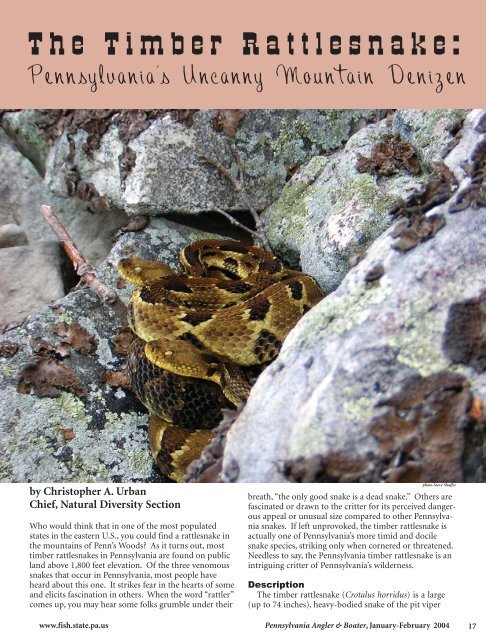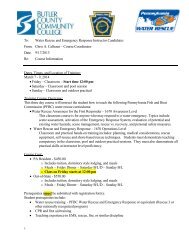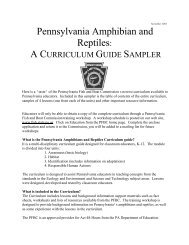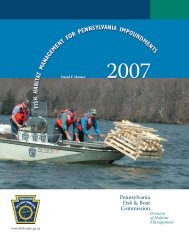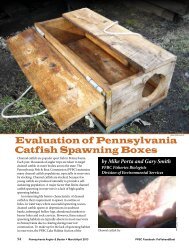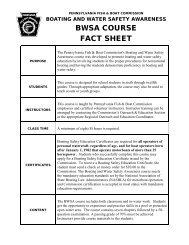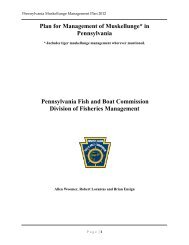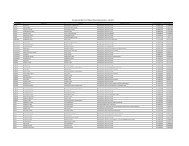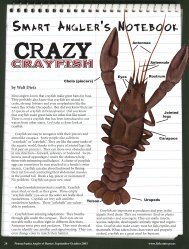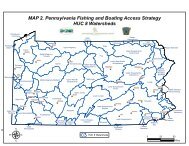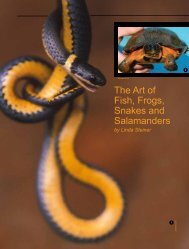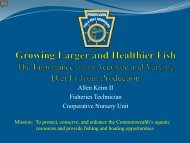The Timber Rattlesnake - Pennsylvania Fish and Boat Commission
The Timber Rattlesnake - Pennsylvania Fish and Boat Commission
The Timber Rattlesnake - Pennsylvania Fish and Boat Commission
You also want an ePaper? Increase the reach of your titles
YUMPU automatically turns print PDFs into web optimized ePapers that Google loves.
<strong>The</strong> <strong>Timber</strong> <strong>Rattlesnake</strong>:<br />
<strong>Pennsylvania</strong>’s Uncanny Mountain Denizen<br />
by Christopher A. Urban<br />
Chief, Natural Diversity Section<br />
Who would think that in one of the most populated<br />
states in the eastern U.S., you could find a rattlesnake in<br />
the mountains of Penn’s Woods? As it turns out, most<br />
timber rattlesnakes in <strong>Pennsylvania</strong> are found on public<br />
l<strong>and</strong> above 1,800 feet elevation. Of the three venomous<br />
snakes that occur in <strong>Pennsylvania</strong>, most people have<br />
heard about this one. It strikes fear in the hearts of some<br />
<strong>and</strong> elicits fascination in others. When the word “rattler”<br />
comes up, you may hear some folks grumble under their<br />
photo-Steve Shaffer<br />
breath, “the only good snake is a dead snake.” Others are<br />
fascinated or drawn to the critter for its perceived dangerous<br />
appeal or unusual size compared to other <strong>Pennsylvania</strong><br />
snakes. If left unprovoked, the timber rattlesnake is<br />
actually one of <strong>Pennsylvania</strong>’s more timid <strong>and</strong> docile<br />
snake species, striking only when cornered or threatened.<br />
Needless to say, the <strong>Pennsylvania</strong> timber rattlesnake is an<br />
intriguing critter of <strong>Pennsylvania</strong>’s wilderness.<br />
Description<br />
<strong>The</strong> timber rattlesnake (Crotalus horridus) is a large<br />
(up to 74 inches), heavy-bodied snake of the pit viper<br />
www.fish.state.pa.us <strong>Pennsylvania</strong> Angler & <strong>Boat</strong>er, January-February 2004 17
18<br />
family (Viperidae). This snake has transverse “V”-shaped<br />
or chevronlike dark b<strong>and</strong>s on a gray, yellow, black or<br />
brown body color. <strong>The</strong> tail is completely black with a<br />
rattle. <strong>The</strong> head is large, flat <strong>and</strong> triangular, with two<br />
thermal-sensitive pits between the eyes <strong>and</strong> the nostrils.<br />
<strong>The</strong> timber rattlesnake’s head color has two distinct color<br />
phases. <strong>The</strong> black phase has a completely black head with<br />
black eyes, <strong>and</strong> the yellow phase has a yellow head <strong>and</strong><br />
yellow eyes. <strong>The</strong> pupils are elliptical. <strong>The</strong> dorsal scales<br />
are strongly keeled, giving it a “rough” appearance. <strong>The</strong><br />
ventral (underside) area of the snake is whitish to creamcolored<br />
with small, dark stippled markings. Male <strong>and</strong><br />
female timber rattlesnakes differ in size <strong>and</strong> subcaudal<br />
(scales on the underside of the tail) scale count. <strong>The</strong><br />
average length of males is 43 inches. <strong>The</strong> average length<br />
of females is 36 inches. Adult males have longer, thinner<br />
tails with 21 or more subcaudal scales between the vent<br />
<strong>and</strong> the base of the rattle.<br />
Life history<br />
<strong>Timber</strong> rattlesnakes inhabit the mountainous regions<br />
of <strong>Pennsylvania</strong>. <strong>The</strong>y prefer upl<strong>and</strong> forested areas where<br />
they forage for small mammals like mice <strong>and</strong> chipmunks.<br />
Talus slopes, rocky ledges <strong>and</strong> outcrops, <strong>and</strong> boulder<br />
fields with open, primarily southern-facing exposures,<br />
create conditions ideal for basking. Basking aids in<br />
thermoregulation, which facilitates maintenance of<br />
metabolic rates <strong>and</strong> assists with digestion <strong>and</strong> gestation.<br />
<strong>The</strong>se southern exposures are also where the rattlesnakes<br />
brumate (hibernate) in dens. Dens consist of rocky<br />
crevices, outcrops or rocky slopes that occur near forested<br />
openings, which are used for basking in the spring <strong>and</strong><br />
fall.<br />
<strong>Timber</strong> rattlesnakes emerge (egress) from their dens in<br />
mid-April to late April, <strong>and</strong> they remain active through<br />
October. Adult males may travel up to two miles from<br />
the den before returning in the fall. Conversely, nongravid<br />
females may move about a mile from the den, <strong>and</strong><br />
gravid females stay very close to the den, moving less than<br />
200 yards.<br />
<strong>Rattlesnake</strong>s are ambush predators. <strong>The</strong>y detect the<br />
trails of rodent prey on the forest floor using their<br />
tongues <strong>and</strong> specialized scenting organs. <strong>The</strong>ir camouflage<br />
colors let them blend perfectly into their forest floor<br />
surroundings. <strong>Rattlesnake</strong>s wait for a rodent to pass by<br />
on an already established trail before striking them with a<br />
venomous bite. Using their pit organs as thermal sensors,<br />
they can detect the body heat of their prey from a distance.<br />
<strong>The</strong>se heat detection organs are especially helpful<br />
in locating warm-blooded prey at night. <strong>Rattlesnake</strong><br />
venom is hemolytic, which means it destroys red blood<br />
cells <strong>and</strong> quickly debilitates the prey’s central nervous<br />
system, causing rapid death. <strong>The</strong> snake trails its bitten<br />
but escaped prey by scent.<br />
Envenomated prey is typically dead by the time the<br />
snake catches up to it. After swallowing its prey whole,<br />
the timber rattlesnake seeks solar heat exposure in an<br />
<strong>Pennsylvania</strong> Angler & <strong>Boat</strong>er, January-February 2004<br />
Researchers draw blood from a “tubed” timber rattlesnake.<br />
Blood samples help researchers with a continuing DNA<br />
sampling project.<br />
open, rocky area to aid digestion of its meal.<br />
<strong>The</strong> snakes move from basking area to basking area in a<br />
circular pattern throughout their active season. <strong>Timber</strong><br />
rattlesnakes begin traveling toward their den sites in<br />
August <strong>and</strong> enter their dens for winter dormancy in late<br />
September through October.<br />
Females reach sexual maturity at 7 to 8 years old.<br />
Males reach sexual maturity at age 5. <strong>Timber</strong> rattlesnakes<br />
mate in late summer to early fall in <strong>Pennsylvania</strong>. Females<br />
hold the sperm until June of the next year, at which<br />
time fertilization occurs. <strong>The</strong> young are born live in early<br />
fall (late August to September). <strong>The</strong> average litter size is<br />
five to nine. Individual females reproduce at intervals of<br />
about two to three years. Because gravid females infrequently<br />
feed during the summer immediately preceding<br />
birth of their offspring, the intervening years are necessary<br />
to store sufficient body fat to sustain them through<br />
gestation <strong>and</strong> hibernation. So despite a potential lifespan<br />
of up to 30 years, a female timber rattlesnake may<br />
bear young only 10 to 15 times during its life.<br />
<strong>The</strong>re appears to be high juvenile mortality, because<br />
many young timber rattlesnakes fall prey to natural<br />
predators such as crows, ravens, hawks <strong>and</strong> carnivorous<br />
mammals. Adult timber rattlesnakes have few natural<br />
enemies except humans, whose activities have the greatest<br />
direct effects (roadkills, poaching) <strong>and</strong> indirect effects<br />
(habitat loss <strong>and</strong> degradation) on the timber rattlesnake<br />
population.<br />
Distribution<br />
Two timber rattlesnake subspecies are currently<br />
recognized. <strong>The</strong> northern subspecies (Crotalus horridus<br />
horridus) ranges from southern New Hampshire to New<br />
York <strong>and</strong> southern Ontario, through western Massachusetts<br />
<strong>and</strong> Connecticut, into northern <strong>and</strong> southeast New<br />
Jersey, <strong>and</strong> west through <strong>Pennsylvania</strong> to Illinois <strong>and</strong><br />
southwestern Wisconsin <strong>and</strong> southeast Minnesota, then<br />
south to eastern Texas, <strong>and</strong> east to northern Florida. A<br />
southern subspecies known as the canebrake rattlesnake<br />
(C. h. atricaudatus) inhabits wetl<strong>and</strong>s along the Atlantic<br />
Coastal Plain, but it is absent from <strong>Pennsylvania</strong>.<br />
Before European settlement, the timber rattlesnake’s<br />
www.fish.state.pa.us<br />
photo-Aura Stauffer
photo-Jim Chestney<br />
range was thought to have spanned most of <strong>Pennsylvania</strong>.<br />
<strong>The</strong> current range is restricted to the more rugged, least<br />
accessible <strong>and</strong> less populated regions of the Commonwealth.<br />
Today, timber rattlesnakes occur in forested,<br />
mountainous regions that encompass mainly the central<br />
<strong>and</strong> northeast regions of <strong>Pennsylvania</strong>.<br />
Threats <strong>and</strong> conservation<br />
Given the slow maturity, high apparent juvenile<br />
mortality, <strong>and</strong> over-exploitation of the timber rattlesnake<br />
<strong>and</strong> its habitat, the timber rattlesnake is vulnerable to<br />
decline. Presently, the timber rattlesnake appears to be<br />
declining across its range <strong>and</strong> in <strong>Pennsylvania</strong>. <strong>The</strong><br />
decline of the timber rattlesnake is attributed mainly to<br />
human activities related to habitat alteration, overhunting<br />
<strong>and</strong> poaching. Currently, the timber rattlesnake is<br />
protected or is a species of concern in more than half the<br />
number of states in which it occurs. In <strong>Pennsylvania</strong>, it is<br />
currently listed as a c<strong>and</strong>idate species, which means that it<br />
could achieve threatened or endangered status.<br />
Through time we have come a long way in timber<br />
rattlesnake conservation. At one time, some <strong>Pennsylvania</strong><br />
counties offered a bounty on timber rattlesnakes, <strong>and</strong><br />
they were considered a nuisance species to be rounded up<br />
Female yellow-phase timber rattlesnake “soaking.”<br />
<strong>Rattlesnake</strong>s often exhibit this behavior before shedding their<br />
skins. However, this female appears to have shed already.<br />
<strong>and</strong> eliminated. <strong>Rattlesnake</strong>s were largely unregulated<br />
until the 1970s, when the <strong>Pennsylvania</strong> <strong>Fish</strong> <strong>Commission</strong><br />
took responsibility for the protection of reptiles <strong>and</strong><br />
amphibians occurring in the Commonwealth. Today, the<br />
timber rattlesnake is legally protected in <strong>Pennsylvania</strong> <strong>and</strong><br />
is managed with a regulated season <strong>and</strong> possession limit.<br />
In addition, the <strong>Fish</strong> & <strong>Boat</strong> <strong>Commission</strong>’s Natural<br />
Diversity Section reviews <strong>and</strong> comments on development<br />
projects that might adversely affect timber rattlesnakes<br />
<strong>and</strong> their habitat. <strong>The</strong> Natural Diversity Section is also<br />
involved in continuing research projects including<br />
assessing, inventorying <strong>and</strong> monitoring the viability of<br />
timber rattlesnake dens.<br />
Tagging a rattlesnake. Above are PIT tags, tag reader/scanner,<br />
<strong>and</strong> injector. Pit tags are injected under the rattlesnake’s belly<br />
plates. PIT-tagged snakes will be used for research,<br />
population esitmates <strong>and</strong> perhaps law enforcement purposes.<br />
Site assessment <strong>and</strong> inventory project<br />
It is well-known that timber rattlesnakes use ancestral/<br />
communal den sites for hibernating. Dens are a central<br />
focus in the life history <strong>and</strong> ecology of timber rattlesnakes.<br />
Free-ranging <strong>and</strong> dispersing adult males can<br />
move several miles from a den. However, the majority of<br />
the individual timber rattlesnakes, including neonates,<br />
gravid females <strong>and</strong> subadults, which are found at a given<br />
den site, spend much of their time in these areas basking,<br />
feeding, mating <strong>and</strong> giving birth within several hundred<br />
yards of the den site. <strong>The</strong>refore, protecting these dens<br />
<strong>and</strong> the surrounding habitat is crucial to rattlesnake<br />
conservation.<br />
In the late 1980s <strong>and</strong> early 1990s, <strong>Commission</strong> nongame<br />
biologists began compiling more refined location<br />
information from amateur <strong>and</strong> professional herpetologists<br />
concerned with the conservation of <strong>Pennsylvania</strong>’s<br />
timber rattlesnakes. Over 600 historic rattlesnake “dens”<br />
were mapped in <strong>Pennsylvania</strong>. Many reported sightings<br />
are not true dens, so field checking of the sites is needed<br />
to assess the condition of the local habitats. Unfortunately,<br />
in recent years, staff shortages <strong>and</strong> lack of funding<br />
have resulted in biologists checking <strong>and</strong> assessing only a<br />
www.fish.state.pa.us <strong>Pennsylvania</strong> Angler & <strong>Boat</strong>er, January-February 2004 19<br />
Tagging photo-Damian Yost; equipment photo-Chris Urban
20<br />
relatively small number of the sites for their habitat type<br />
<strong>and</strong> quality. Many sites are merely basking areas that are<br />
used seasonally, <strong>and</strong> they can occur miles from dens, or<br />
they are rookeries (basking areas where gravid females<br />
give birth) that are usually within 300 yards of a den.<br />
<strong>The</strong> <strong>Commission</strong> has important short-term <strong>and</strong> longterm<br />
needs concerning the location accuracy, classification<br />
<strong>and</strong> viability information of these historic rattlesnake<br />
sites. <strong>The</strong> most immediate need for this information<br />
comes from the dem<strong>and</strong> of environmental review<br />
projects. Environmental reviews address concerns about<br />
habitat alteration or destruction, the primary reasons for<br />
the timber rattlesnake’s decline across its range. Each<br />
year, <strong>Commission</strong> biologists comment on about 3,000<br />
proposed permitted development projects, which include<br />
highway <strong>and</strong> bridge projects; subdivisions; natural gas,<br />
fiber optic <strong>and</strong> petroleum pipelines; <strong>and</strong> cell towers.<br />
<strong>Timber</strong> rattlesnake location information, site classification<br />
<strong>and</strong> viability information are vital to biologists when<br />
providing recommendations to developers for avoiding<br />
<strong>and</strong> minimizing adverse effects to these dens during the<br />
environmental review <strong>and</strong> consultation process. In<br />
addition, the <strong>Commission</strong> needs this location <strong>and</strong><br />
viability information to assess the population health <strong>and</strong><br />
status of timber rattlesnakes in <strong>Pennsylvania</strong>.<br />
Anecdotal reports from biologists <strong>and</strong> amateur<br />
“herpers” interested in timber rattlesnakes are consistent<br />
with the preliminary results of the <strong>Commission</strong>’s inventory<br />
study. Preliminary results indicate that the population<br />
of timber rattlesnakes in northcentral <strong>Pennsylvania</strong>,<br />
which occurs mainly on state forest l<strong>and</strong> <strong>and</strong> at the core<br />
of their <strong>Pennsylvania</strong> distribution, is doing fairly well.<br />
However, the populations on the periphery of their range<br />
in <strong>Pennsylvania</strong>, <strong>and</strong> those close to human habitation,<br />
appear to be in decline. Denning <strong>and</strong> basking areas are<br />
either not currently used, show signs of disturbance, or<br />
are encroached on by development. <strong>The</strong>se areas include<br />
the South Mountain population in southcentral <strong>Pennsylvania</strong>,<br />
the northeast population on the Pocono Plateau,<br />
<strong>and</strong> the southwest population that occurs on the Allegheny<br />
Plateau <strong>and</strong> in the Laurel Highl<strong>and</strong>s. Is there more to<br />
the story? <strong>The</strong> <strong>Commission</strong>’s study will reveal the<br />
population status of the snake, <strong>and</strong> most likely lead to<br />
some important management decisions regarding the<br />
snake.<br />
<strong>The</strong> future<br />
<strong>Timber</strong> rattlesnakes in <strong>Pennsylvania</strong> have an interesting<br />
past <strong>and</strong> questionable future. As the human population<br />
in <strong>Pennsylvania</strong> increases, human encounters with<br />
snakes will most likely increase, further threatening the<br />
existence of this snake in Penn’s Woods. We know that<br />
<strong>Pennsylvania</strong> has about 12 million human residents. As<br />
yet, we do not know for sure how many timber rattlesnakes<br />
are left. However, it is clear that if history is an<br />
example, the snakes usually come out on the wrong side<br />
of the equation. <strong>The</strong>refore, accurate population, distri-<br />
<strong>Pennsylvania</strong> Angler & <strong>Boat</strong>er, January-February 2004<br />
bution, genetics <strong>and</strong> even basic life history data are<br />
needed so that informed, conservation-based decisions<br />
about the protection of this species can continue to be<br />
made. A public armed with facts instead of fears is one of<br />
the best tools for those who would see this symbol of<br />
wilderness persist in <strong>Pennsylvania</strong>. <strong>The</strong> <strong>Commission</strong><br />
encourages you to admire these animals for their unique<br />
place in the world <strong>and</strong> support efforts to conserve their<br />
populations.<br />
Visit the <strong>Commission</strong>’s web site, www www.fish.stat<br />
www .fish.stat .fish.state.p<br />
.fish.stat e.p e.pa.us e.p a.us a.us, a.us<br />
for a wealth of information, products <strong>and</strong> publications<br />
on <strong>Pennsylvania</strong> reptiles <strong>and</strong> amphibians.<br />
<strong>Pennsylvania</strong> <strong>Timber</strong> <strong>Rattlesnake</strong><br />
Population Study<br />
<strong>The</strong> <strong>Commission</strong> has begun a study on the <strong>Pennsylvania</strong><br />
timber rattlesnake population through a State Wildlife<br />
Grant obtained from the U.S. <strong>Fish</strong> & Wildlife Service.<br />
<strong>The</strong> first aspect of the study concerns assessment <strong>and</strong><br />
inventory of historic rattlesnake sites. In the spring of<br />
2003, six teams of experienced rattlesnake surveyors<br />
started confirming <strong>and</strong> classifying historic rattlesnake<br />
sites as dens, rookeries or basking areas. Precise locations<br />
were obtained for the sites, as well as the boundaries of<br />
surrounding suitable habitat, with the use of h<strong>and</strong>held<br />
global positioning system (GPS) receivers. Teams assessed<br />
threats <strong>and</strong> viability at these sites.<br />
<strong>The</strong> study also includes marking individual snakes<br />
using “PIT” tagging technology at targeted populations of<br />
rattlesnakes. A PIT tag, passive implant transponder, is a<br />
device no larger than a grain of rice that is inserted under<br />
the snake’s skin. PIT tags use barcode technology so that<br />
a tagged snake reveals a numeric code when a h<strong>and</strong>held<br />
scanner is passed over its body. This allows biologists to<br />
follow the fate of individual animals.<br />
PIT-tagged rattlesnakes will be used for future research,<br />
population estimates <strong>and</strong> perhaps law enforcement<br />
purposes. In addition, blood samples are collected<br />
to assist with a continuing DNA sampling project, funded<br />
by the Wild Resource Conservation Fund. Leading this<br />
project is Dr. Howard Reinert of the College of New<br />
Jersey in Trenton, New Jersey. Dr. Reinert is studying the<br />
population genetics of timber rattlesnakes in <strong>Pennsylvania</strong>.<br />
Future aspects of the <strong>Commission</strong>’s rattlesnake study<br />
will include documenting new locations of timber<br />
rattlesnake dens in the gaps of their range across <strong>Pennsylvania</strong>.<br />
Overall, this study will assist the <strong>Commission</strong> in<br />
protecting rattlesnake dens by collecting baseline data<br />
that can be used in the environmental review process.<br />
<strong>The</strong> study will ultimately provide vital information on<br />
the relative population health <strong>and</strong> status of the timber<br />
rattlesnake in <strong>Pennsylvania</strong>.—CAU.<br />
www.fish.state.pa.us


